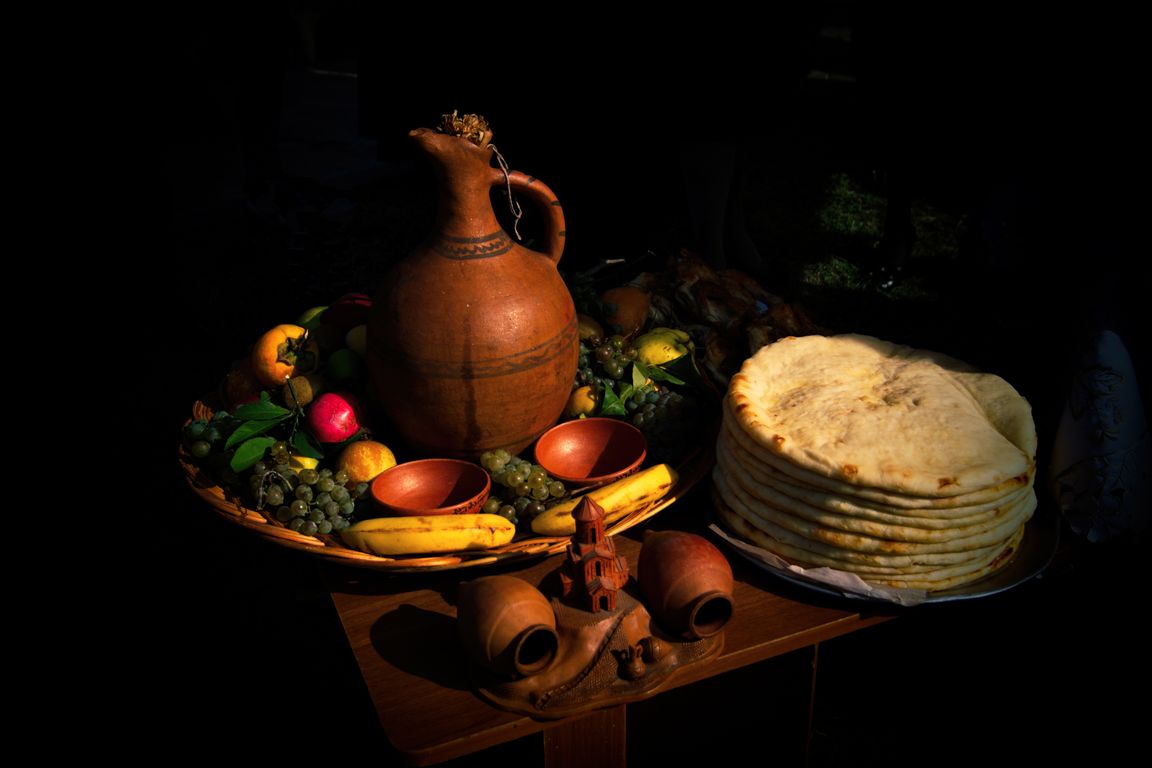The Georgian kitchen is as old and rich as the history of Georgia itself. The geographical location and climate of the country contributes to the large variety of fresh produce. Georgia’s regions have very particular dishes which differ from each other, even though each of them can be found in the kitchens of every Georgian household. Khachapuri is the most popular dish in Georgia. Each region of Georgia has its own recipe for making khachapuri. For example, in Imereti the khachapuri is thin and in Adjara the khachapuri is heartier and prepared with an egg in the center. In Svaneti the khachapuri is prepared with meat and different spices.
Georgians are extremely hospitable people. If you have the good fortune to visit Georgia you will receive an invitation not only from one family, but most likely their neighbors will also invite you to a Georgian traditional feast. Do not be surprised if your refusal of an invitation insults Georgians. While you are at a feast make sure to taste all the different dishes. If you like something please compliment your host’s cooking and be ready to eat more!
Along with Georgian dishes each family has its own method of making wine and for this they choose their favorite grape. You will taste several different wines in a short time, as every Georgian family has plenty of wine in storage.
MEALS
Basturma: Air-dried beef served in thin slices. The nearest equivalent is pas-tram.
Chakhokhbili: Chicken (pheasant if available) stew with tomato and every fresh vegetable in season, especially aromatic coriander and lots of onion.
Chakapuli: A stew of lamb cubes, tkemali (a green plum), tarkhuna (tarragon), and scallions.
Chicken chkmeruli: Chicken pressed between two clay plates and fried.
Khinkali: Bell-shaped meat dumplings filled with ground beef, pork, lamb, and spices. Black pepper, always provided, should be sprinkled liberally. This delicacy is eaten by holding the doughy twisted end, which is not consumed. Special restaurants (sakhinkle) specialize in khinkali; they rarely appear in the home. Chefs from Dusheti are considered experts of khinkali preparation.
Kharcho: Meat and rice soup highly spiced with black and cayenne peppers.
Khashi: Soup of tripe, cow trotters and lots of garlic. Eaten in the morning, this is an excellent remedy for a hangover.
Mtsvadi: A lamb or beef shish kebab of Caucasian rather than Georgian origin. Found on most restaurant menus, it is the preferred dish for picnics in the countryside. Mtsvadi is usually prepared by men, as with the preparation of Spanish paella.
Satsivi: Chunks of turkey (sometimes chicken) in a sauce of corn flour, saffron, and enough ground walnuts to give a granular consistency; always served at room temperature.
Badrijani: Baby eggplants served whole with their skins and stuffed with a ground walnut paste seasoned with oil and spices.
Chanakhi: Whole tomatoes baked in a clay pot with greens, garlic, eggplant, green peppers and chunks of lamb.
Lobio: Kidney beans boiled with water in a ceramic pot and then lightly crushed with a pestle and mixed with coriander and a spice called umbalo (European pennyroyal).
Pkhali: Comes in two types, green and red. Both consist of minced spinach mixed with ground walnuts, the famous khmeli-suneli spices, garlic, and a little vinegar with a topping of pomegranate seeds.
SAUCES
Ajika: This spicy condiment hails from Abkhazia and is made from red chill peppers and herbs.
Bazhe: A sauce of ground walnuts, walnut oil, water, and a combination of Georgian spices known as khmeli-suneli (the exact mixture varies with every cook).
Tkemali: A spicy, tart, green plum sauce, which is the essential accompaniment for shish kebab or any other meat.
BREADS
Chadi: Cornbread fried or baked in an oval shape.
Ghomi: The Georgian equivalent of Italian polenta. Crushed corn kernels to which corn flour is added, continually stirred, and cooked for a long time. Ghomi is often served with slices of suluguni cheese placed in the middle of the hot corn puree to melt.
Khachapuri: A cheese pie made of dough, suluguni cheese (resembles mozzarella), and sometimes egg. If Georgians had immigrated to the United States in the same numbers as Italians, these cheese pies would no doubt be as familiar and beloved as pizza, which minus the tomato sauce they most resemble. Every housewife prepares this dish somewhat differently, and it exhibits marked regional characteristics as well. There are four types of khachapuri:
Imeruli: Of Imeretian origin and most often found in homes, it is commonly baked with Imeruli cheese.
Achma: Usually made of many thin layers of dough, cheese, and butter, this type of khachapuri resembles lasagna and comes from Adjara.
Adjaruli: A version similar to Imeruli except it is served open-laced with an egg beaten into the cheese center with a fork; also comes from Adjara.
Penovani: With many thin layers of dough like a pastry and suluguni cheese, this type of khachapuri is found throughout Georgia but especially fine in Tbilisi.
Puri: Bread (both round and crusty, and long and doughy) that accompanies every meal. “Dedaspuri” is long and doughy and is often featured in the paintings of Pirosmani.
SWEETS
Churchkhela: A candy made of boiled grape skins and walnuts, sometimes combined with raisins. Never found in restaurants, but sold in village markets or along country roads. Walnuts are strung on a thread and dipped into a hot grape mixture, then hung to solidify.
Gozinaki: A candy made of boiled honey and sugar poured over a bed of walnuts, closely resembling a soft version of American “peanut brittle.”
MILK PRODUCTS
Matsoni: Georgian yogurt.
Nadugi: Curd mixed with mint.


 Deutsch
Deutsch Русский
Русский